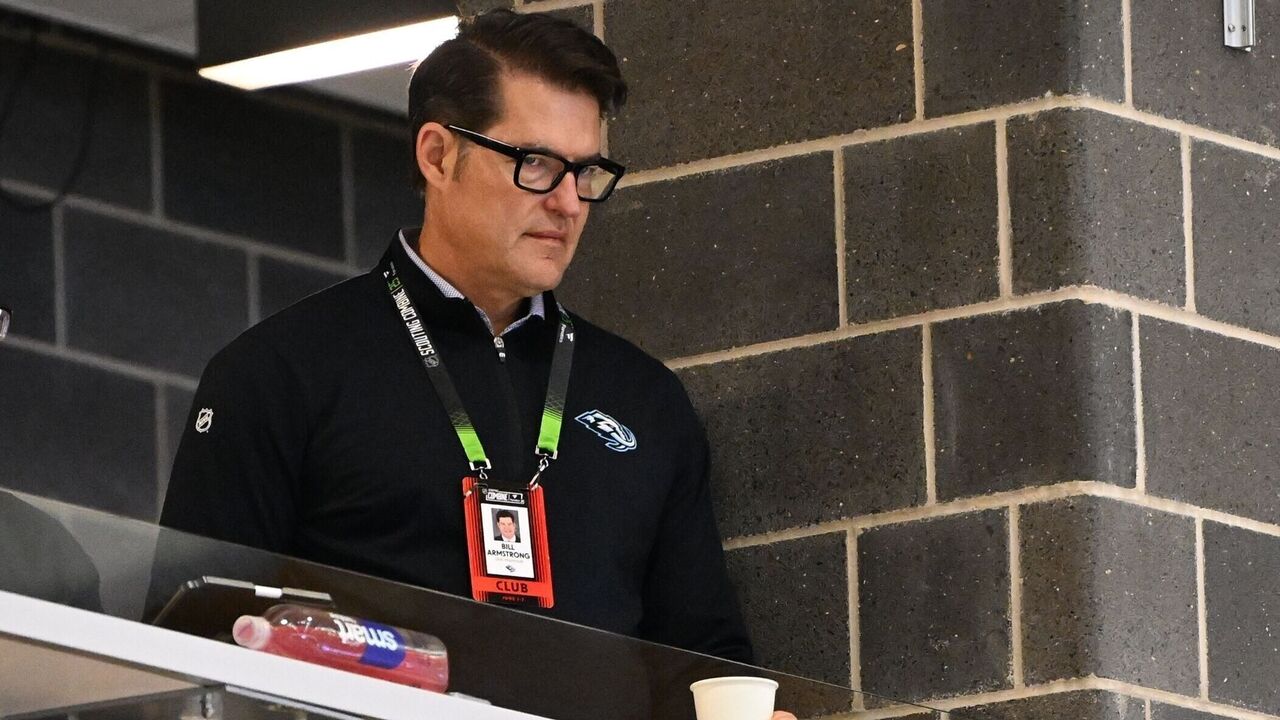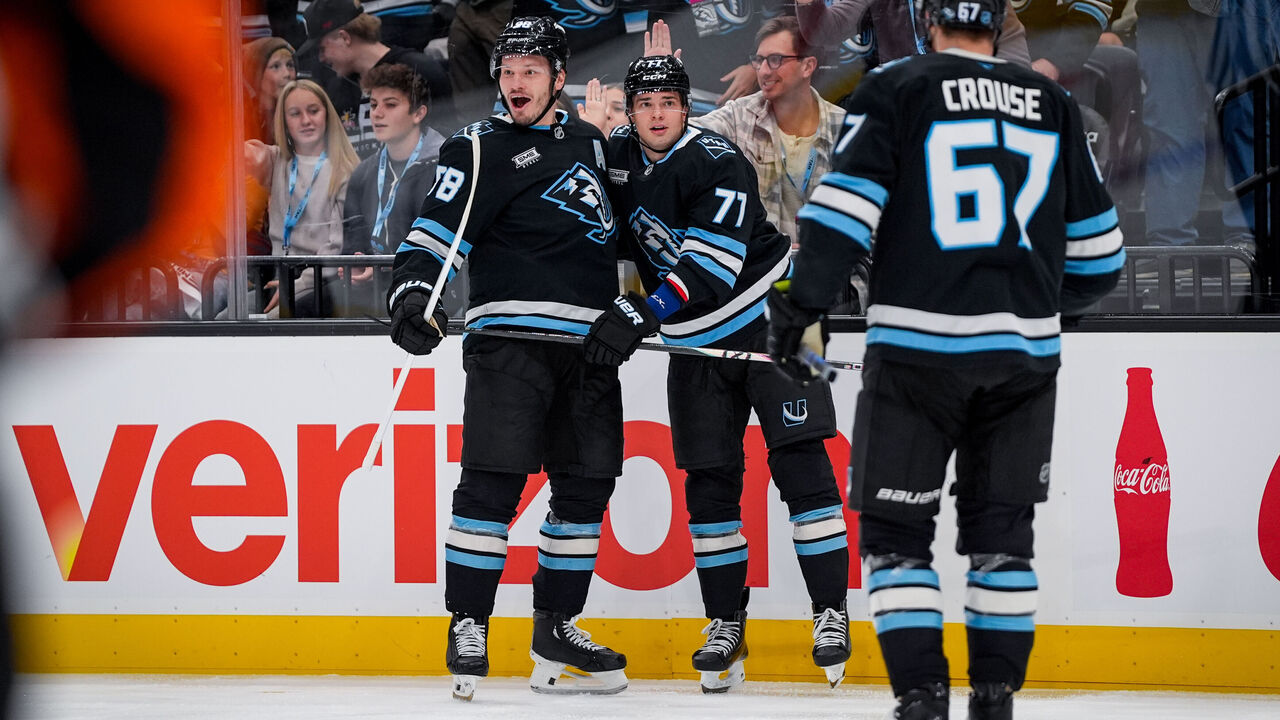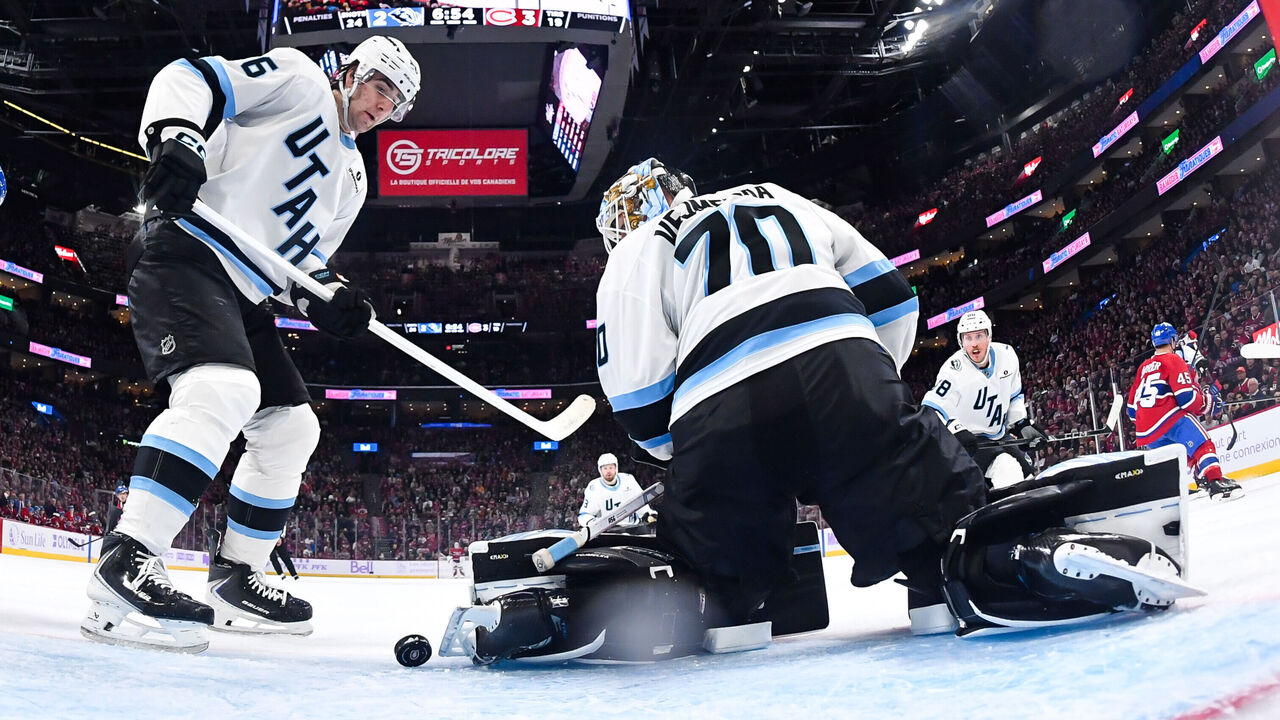The Mammoth are coming (soon)
Utah Mammoth general manager Bill Armstrong is a large man. A pro defenseman in the 1990s, he's listed at 6-foot-5, 220 pounds on HockeyDB.
Still, it took until this spring for the 55-year-old to be called a mammoth man.
Armstrong was walking through a Moncton, New Brunswick, hotel in May, eager to drop off his luggage and head out to scout some players, when he drew the attention of other guests. His golf shirt, emblazoned with the brand-new, ice-age Mammoth logo, instantly became the focus of their fascination.

"I checked in, got my room key, and when I started to go upstairs, all of these kids in town for a youth hockey tournament followed me into the elevator and to my room," Armstrong recalled in a recent sit-down interview with theScore.
"They were chanting, 'We know you're on this floor, Mammoth Man! We know you're on this floor! We want the Mammoth! We want the Mammoth! We want the Mammoth!' It was great. It was unexpected. I was laughing my ass off."
The anecdote is both amusing and revealing. Unlike the dysfunctional, cheap, and largely irrelevant Arizona Coyotes, the Mammoth franchise has charisma - this inherent likability - because it's in capable hands. The Smith Entertainment Group has created a palpable buzz locally and nationally through thoughtful reveals of the nickname, logo, jerseys, and mascot. Ownership has done exactly what various Coyotes owners didn't do by renovating the home arena, building what Armstrong calls a "state-of-the-art" practice and training facility, and allowing the GM to spend freely on players.
All of this in the 19 months since tech billionaire Ryan Smith bought the Coyotes' hockey assets and moved the club to Utah's capital in Salt Lake City.
"They've got high standards," Armstrong said of Smith and his wife, Ashley, who also own the NBA's Utah Jazz. "We're very grateful for how they conduct their business and, honestly, it really inspires us on the hockey side."

Utah's 10-7-3 record puts them on pace for 94 points, right around the typical Western Conference cutline and a modest five-point improvement from the previous season. The Coyotes/Mammoth last made the playoffs in the pandemic-shortened 2019-20 campaign, and MoneyPuck lists their 2025-26 odds at 66.5%.
Armstrong, hired as Coyotes GM in September 2020, isn't the type to get caught up in the moment - whether his team is rolling (seven-game winning streak in October) or grasping for consistency (2-5-3 in its last 10 games).
The former scout and assistant GM for the Blues knows that some parts of the team-building process can't be forced if the ultimate goal is to develop a sustainable winner. To Armstrong, the evolution involves four distinct phases.
First comes the roster teardown and search for cornerstone players. Next, in Phase 2, the core pieces play competitive hockey alongside a solid supporting cast. Phase 3 calls for night-to-night consistency and a return to the postseason. In the fourth and final phase, the team is mature, deeper, and battle-tested, ready to win playoff series and challenge for the Stanley Cup.
"When you're 80% done the build, you can fill in the rest of the roster with guys from the minors, other small moves," Armstrong said. "But there are still pieces for us to add - elite pieces. I figure we're about 60% of the way there."
Utah's nucleus consists of 10 players: seven forwards, two defensemen, and a goalie, all under the age of 30. Clayton Keller, Nick Schmaltz, Logan Cooley, Dylan Guenther, and JJ Peterka all have electric qualities - quick, intelligent, highly skilled, and a threat to break a game open at any moment. Barrett Hayton and Jack McBain are versatile centers. Mikhail Sergachev and Dmitri Simashev are big and dynamic blue-liners facing the other team's best players every night. Fan favorite Karel "Veggie" Vejmelka is the clear-cut No. 1 goalie.

Peterka, McBain, and Vejmelka are signed through the 2029-30 season, while Sergachev, Guenther, and Cooley run through 2030-31, 2032-33, and 2033-34, respectively. Those six players will account for just $42 million against the salary cap once Cooley's eight-year, $80-million extension kicks in next year.
Meanwhile, Keller's second contract and Simashev's entry-level deal expire after 2027-28. Hayton and leading scorer Schmaltz are the nucleus' two unknowns as pending free agents - the former restricted, the latter unrestricted.
"We had talks at the start of the year," Armstrong said of Schmaltz's representatives. "It's the same (vibe) as the free agents last year - the Brad Marchands, the Sam Bennetts of the world, all of those guys. It's, 'Play it out.' We know where you live. We've got your home address. Play it out."
Regardless of what happens with Schmaltz, the Mammoth boast an enviable top of the lineup and haven't broken the bank to retain several essential pieces. Utah's on a very short list of NHL teams that check off the following four boxes: good enough to make the 2026 playoffs, financially flexible now and for the foreseeable future, impressive prospect pool, loads of draft capital.
The Mammoth play an up-tempo brand of hockey under coach Andre Tourigny. They're a nightmare to defend off the rush, in general, and especially after the other team coughs up the puck. Utah sits second in the league in goals scored within 10 seconds of a five-on-five turnover, according to Sportlogiq, doing it 22 times in 20 games. If only the power play - ranked 29th - could be more effective.

On defense, the Mammoth apply constant pressure on the puck carrier. Their aggressive approach has limited opponents to only 20.1 five-on-five shots on goal per game (tied with Florida for first in the league) and 39.3 five-on-five shot attempts per game (second behind Carolina). One hiccup: Vejmelka and backup Vitek Vanecek have five-on-five save percentages of .883 and .870.
"What is Mammoth hockey?" Armstrong asked rhetorically the morning after a 5-3 loss to the Maple Leafs in early November. "It's fast hockey. Playing for 60 minutes. In your face the whole time. You don't take your foot off the gas. We haven't finished all of our games so far like that, but we're getting there."
Rough translation: Utah is currently stuck between Phases 2 and 3.
For one, the core is young and impressionable ("We can read our press clippings sometimes and get away from our game") and can be too cute with the puck on occasion. That said, Armstrong won't hesitate to add reinforcements if his team remains in the playoff hunt ahead of the trade deadline. He'd love for his players and the fans to taste postseason hockey.
The GM was asked to share the biggest takeaways from his 16-year run with the Blues, who won the Cup in 2018-19, his second-last season in St. Louis.
"Patience," Armstrong said without hesitation.
"Fan bases or ownership groups, they don't really want to hear that. We've made a lot of changes to our team, put our build on steroids a little bit, fast-forwarded it. But you can't fast-forward what the team has to go through to get there. I believe that you need adversity and scars to get to that next step."
John Matisz is theScore's senior NHL writer. Follow John on Twitter/X (@MatiszJohn) or contact him via email ([email protected]).
HEADLINES
- Ducks win in shootout after Sennecke ties game with 0.1 seconds left
- Canadiens recall standout prospect Fowler amid goaltending woes
- Leafs' McMann suspended 1 game for high-sticking Bolts' Bjorkstrand
- Top Shelf: Breaking down every angle of the Quinn Hughes saga
- Malkin week-to-week with upper-body injury